Ponds are an intriguing aspect of any landscape. Sitting by the water can be a relaxing and restorative experience. But when your pond begins to smell, it is no longer a place of sanctuary.
Ponds can have unpleasant smells for multiple reasons. The most common cause is stagnation. Stagnant water is not only unpleasant, but it can also be dangerous. Avoid stagnation through proper pond design and maintenance.
If your pond smells so bad that no one wants to go near it, read on. This article will explain stagnation and some other common pond stench causes. We will then cover some strategies for eliminating these unwanted scents.
The Dangers of Stagnation
The most widespread cause of a smelly pond is stagnation. Stagnation means that the water in your pond has stopped moving.
You may believe that pond water is supposed to be still. A typical understanding of bodies of water may lead you to think that rivers and streams are meant to move while ponds and lakes are meant to be still.
This is not the case. Motionless water is a sign that your pond is on the decline. It will also lead to an accumulation of odor-causing substances such as algae and plant debris.
All bodies of water need to have some movement because it allows for a process called aeration.
Aeration
Aeration is a process in which air is circulated through a liquid to maintain quality and prevent contamination.
Without aeration, your pond will not have enough oxygen in it. This oxygen is needed to support certain types of bacteria in the water.
You may be surprised that supporting bacteria is a goal of pond maintenance. After all, don’t bacteria cause disease?
The truth is that not all bacteria are a detriment. Some of the bacteria in your pond is responsible for decomposing debris.
The Role of “Good” Bacteria
The “good” bacteria feed on debris in your pond. This process cleans the water and prevents a build-up of debris.
Without aeration, these bacteria won’t be able to survive. As a result, debris will accumulate in your pond and may contribute to an unwanted smell.
But if your pond is stagnant, the stench is really the least of your concerns. Stagnant pond water often leads to some serious problems. In some cases, these problems may even be deadly.
Bad Pond Smells and Health Risks
Other than bad smells, here some of the more dangerous results a stagnant pond will cause.
- Mosquitoes
- Rodents
- “Bad” Bacteria and Parasites
- Algae Blooms
Some of these factors will lead to bad smells. Some will make you sick. And some are so bad that they will do both. Read on to learn about each of these risks.
Mosquitos
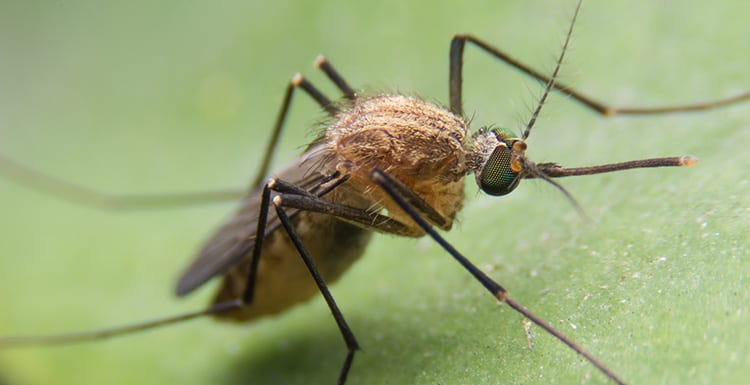
Still water is where mosquitos like to breed. These insects can carry dangerous diseases like the following.
- West Nile Virus
- Malaria
- Dengue Fever
- Zika Virus
All of these diseases can drastically alter your life. Keep your water moving to prevent mosquitos from moving in and multiplying. Doing so might just save your health or that of a loved one.
Rodents
Like mosquitoes, some rodents are also attracted to stagnant water. The animals listed below may try to use your still pond water as a drinking source.
- Rats
- Mice
- Raccoons
- Bevers
These rodents can carry diseases as well. The disease they are most likely to spread is called Giardia.
Giardia refers to a parasite that causes intestinal infections in humans. It is known to be one of the leading waterborne diseases in the United States.
But rodents are not just a disease risk. They may also harm your property.
By attracting rodents to your pond, you are also encouraging them to forage for food and build nests nearby. This can lead to damages to your property that may be expensive to fix.
“Bad” Bacteria and Parasites
While there are some good bacteria that you want to live in your pond, there are other types of bacteria you want to eliminate. These bacteria are a detriment on two fronts.
First, they can cause bad smells. But more importantly, they can easily spread disease to you, or your pets.
Here are some technical names for the disease-causing parasites and bacteria and that can appear in stagnant ponds.
- Cryptosporidium parvum
- Giardia lamblia
- E. coli
The diseases that these microbes cause can easily spread to anyone who touches stagnant water. If your pond is stagnant, make sure that you, your children, and your pets stay away.
Algae Bloom
Algae blooms are another common problem with stagnant ponds. Again, these blooms both smell and harmful.
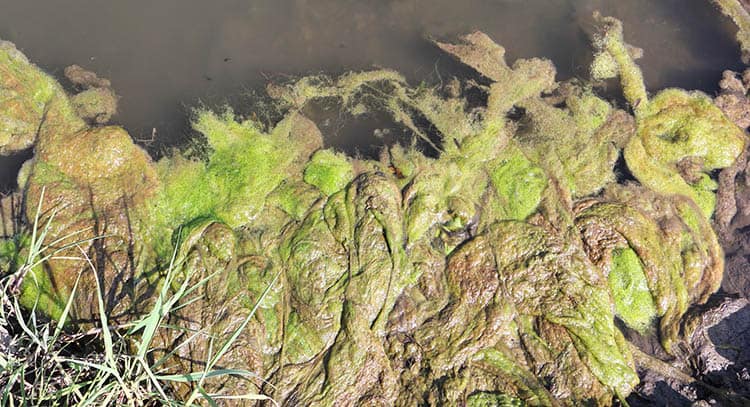
Algae blooms are the result of a bacteria called cyanobacteria. This bacteria spreads rapidly. Because it often occurs in high volumes, it is visible to the naked eye.
At the very least, this is a benefit because you can tell if your pond has an algae bloom just by looking at it. If you are familiar with the appearance of these blooms you will know to stay away from your pond.
Cyanobacteria accumulate in such high amounts that they often look like foam. They also change the color of the water in which they live. The coloration can take on of the following hues
- Blue-green
- Reddish Brown
- Blue
If you recognize that your pond water has an appearance matching the above descriptions, don’t touch it. If you do, the chances of you getting sick are very high. Even eating a fish contaminated by an algae bloom can cause the following symptoms.
- Vomiting
- Diarrhea
- Neurological issues
- Gastrointestinal pain
In addition to this, algae blooms have a very distinct scent. When algae blooms appear in your pond they will be accompanied by a noticeable musty smell.
To make matters worse, fish often know to avoid these algae. Because of this, the harmful algae blooms are able to spread with little competition. They will even outcompete the harmless green algae that live in your pond.
Beyond Stagnation
The information above is just a brief description of the damages stagnant water can cause. Clearly, bad smells are not the only issue here. So, remember that if your pond has a bad smell, it is likely dangerous to the health of you and your loved ones as well.
Unfortunately, stagnation is not the only reason why your pond might smell. It is the most common cause, but there are more factors to consider.
Poor Filtration
Healthy ponds require filtration. Without filtration, it is likely that waste will continuously accumulate in your pond. This waste carries with it, its own horrible smells.
If untreated, over time, a lack of filtration will allow solids to remain in your pond water. These solids coagulate to form a sludge that settles at the bottom of your pond.
Because this sludge is produced from organic matter, a small amount is ok to have. Actually, to a degree, this organic matter will be a food source for the plants living in your pond.
But with no filtration, the sludge in your pool can easily get out of hand. If the sludge in your pond piles up so much that it reaches the surface of the water, you will notice a smell.
The smell comes from the fact that the sludge is made of decomposing plant matter. This results in a rotten smell. Often, this sludge will be thick and black. If you notice this in your pond, you may have found the source of your smell.
But sources of bad smells do not end there. Odor causing factors we have already covered can lead to another horrible odor.
Animal Death
At times, people describe a bad scent as “smelling like death.” In the case of a smelly pond, death may be the literal cause.
If you have fish or other aquatic species in your pond, they can be affected by the issues detailed above. As we covered, stagnation and lack of filtration can give rise to disease-carrying bacteria and parasites. These disease carriers can cause you to be sick and in extreme cases they may kill your fish.
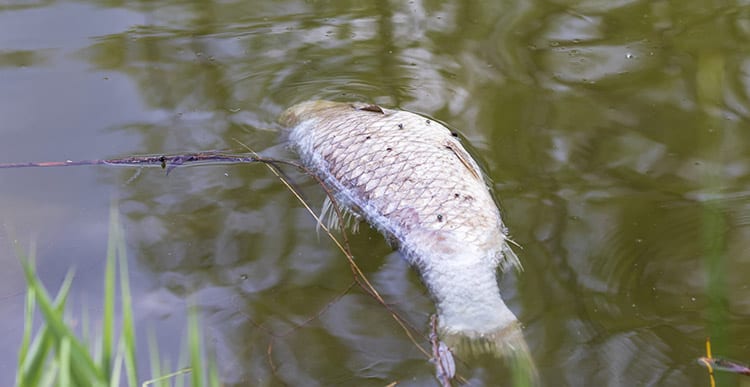
Excessive accumulations of waste can also kill fish. A frozen pond in winter can do so as well. When these fish die, their corpses will rot in the pond water causing a bad smell to fill your yard.
Remember that while you may be smelling dead fish, their death was likely caused by another odor-causing factor such as stagnation, bad filtration, or waste accumulation. In these cases, you will need to resolve the root cause as well as remove the dead fish in order to get rid of the smell.
Getting Rid of the Smell
Recognizing what is causing a bad smell in your pond is a challenge in and of itself. Getting rid of the smell can be difficult as well. Luckily, there are a few reliable tactics to get rid of a bad pond smell.
- Ensure adequate aeration
- Optimize filtration
- Remove excess organic matter
- Replace pond water
The strategy you choose will depend on the specific source of your pond smell.
Ensure adequate aeration
Stagnation is a huge source of pond problems. As such, the most obvious way to eliminate a pond smell is to eliminate stagnant water.
You can achieve this by increasing the amount of aeration in your pond. This means creating a steady current in your pond that runs constantly. There are a few ways you can do this.
- Waterfalls
- Fountains
- Aeration system

The first two items on the list above are more natural ways to increase aeration. But if you are at a point where your pond already smells, you may want to opt for something more potent.
Since it is impossible to have too much aeration, why not choose a full aeration system.
Aeration systems typically run on electricity. They consist of multiple components including pumps, which move the air through the system.
The air enters the pond via aeration discs. These discs should be spread throughout your pond to maximize the spread of the aeration.
Optimize Filtration
A filtration system is a necessary part of a man-made pond. In the wild, the plant life living in the pond provides a natural form of filtration. In a constructed environment, you can always rely on plants to complete this process.
This is where a filtration system comes in handy. These filters are specially designed to remove solid waste from your pond. This ensures that the pond water remains clear and free of solids that can turn into sludge.
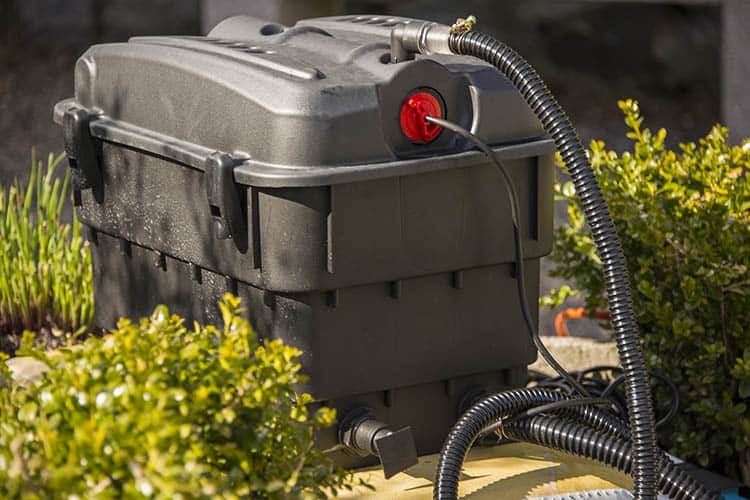
There are three types of filtrations systems for ponds. Each one treats the pond water waste in a different way.
- Biological Filters – These filters use certain bacteria to break down pond waste. Through this process, the waste that is broken down turns into compounds that are released back into the pond. These compounds then serve as fertilizer for the aquatic plants growing in your pond.
- Mechanical filters – Mechanical filters are a straightforward storage system. These filters collect pond waste and trap it in a compartment preventing it from settling in the pond.
- Sterilization Filters – In this system, water is sterilized before returning to the pond. This works by using an ultraviolet bulb that kills microscopic lifeforms in the water.
Regardless of what system you choose, filtration is a critical factor in the health of your pond.
Remove excess organic matter
This may be the simplest solution. If you notice a large build-up of organic matter in your pond, just remove it. This will prevent a massive build-up that will eventually breach the surface and cause a smell.
Just keep an eye on your pond. Notice when plant material and other debris falls in. Remove these materials before they build up.
If your pond is surrounded by trees, you need to be especially vigilant. There are two common tools you can use to remove organic matter from your pond.
- Pond Vacuum
- Netting or Covers
Pond Vacuums
If you have a larger pond, you may want to use a pond vacuum. These machines work just like a regular vacuum. Use your pond vacuum to suck up the sediment that settles at the bottom of your pond. Do this regularly to prevent a sludge build-up.
Pond Nets
There is more variety when it comes to pond nets. But in general, these are better for smaller ponds. Here are some of the common types of pond nets.
- Supported Pond Net – The net is supported by a structure that is above ground and often held in place with stakes.
- Floating Pond Net – This net connects to the edges of the pond and floats directly in the water.
Shop around for a pond net that is durable and made of a long-lasting material like nylon. Look at the size of the net openings as well. The smaller the holes in the net are, the fewer types of leaves will fall through.
Replace Pond Water
Another simple method for freshening up your pond water is to just replace it. This involves two simple steps.
- Take out a percentage of the old water
- Replace the water you removed with fresh clean water
There are a number of tools you can use to remove your pond water. Some of the best options are:
- Pumps
- Shop Vacuums
- Buckets
By removing the water from the pond, you are also removing any harmful smell-causing particles as well. After the water is removed, replace it with water from one of the following sources
- Rainwater
- Tap water
- Well water
The easiest way to refill your pond is to use rainwater. This requires no labor, only patience.
But of course, you can’t always predict when it will rain enough to refill your pond so you can opt to use tap or well water too. The problem with tap water and well water is that is can contain some chemicals that may be harmful to your pond.
Tap water may have high levels of chlorine or chloramine. Well water often has high levels of sulfur. You don’t want too much of either one in your pond.
I also wrote an article about how to add water to a pond and the 9 do’s and don’t that you need to know. You can check it out here.
Seek Professional Assistance
You may not feel confident in your ability to fix your pond water. You may also be uncomfortable with handling dangerous substances like an algae bloom.
In these cases, just contact a pool or pond professional. These companies will be well-equipped to help you fix your pond in the safest possible way.
Pond Design
If you don’t want your pond to smell, the best thing you can do is to prevent it from smelling in the first place. This opportunity comes up as you are designing and building your pond.
To prevent a bad-smelling pond, make sure you have all of the right equipment from the start. By making these smart decisions from the start, you may save yourself some hassle down the road.
A quality pond depends on multiple design components. These elements work together to ensure a functioning pond environment. Included among these are the following.
- Pond Skimmer
- Filter
- Pond Liner
It is possible to build a pond without these parts. But if you do, it is unlikely that your pond will last for a long time. It is also more likely that bad smells will occur.
Pond Skimmer
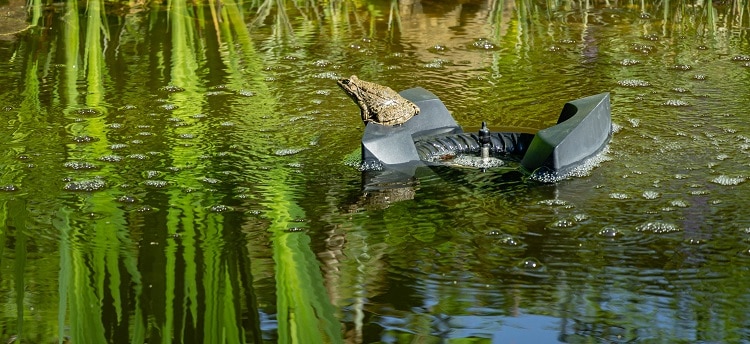
The job of a pond skimmer is to remove debris from the pond water. These devices are usually located at the surface of the pond. I also wrote a full detailed article about if your pond needs a skimmer.
The pump associated with the skimmer will draw the water in. The skimmer then cleans the water in two stages.
- A mesh net collects large debris
- A sponge collects debris too small to be caught by the mesh net.
When water enters the skimmer it usually runs through a mesh net first. This net collects solid debris while the liquid moved through.
The water then typically runs through a sponge-like material. This sponge collects any smaller debris like dust and pollen.
After moving through these layers, the pond water is much cleaner. It is now time for the water to return to the pond.
Skimmers are designed to keep the smooth surface of the pond undisturbed. To do this, many skimmers will return the water at the bottom of the pond rather than the top where it was first collected.
In addition, some skimmers can act as aerators as well. If your skimmer does not serve this function, you will want to consider purchasing a separate aeration system.
Filter
We have already covered the importance of filters. But it is important to note that you should incorporate a filter from the beginning of your pond construction.
This is a preventative measure. Neglecting to install a filter from the beginning will likely result in you needing to buy one later on.
A skimmer is one type of pond filter but there are many options available. Different filters can be incorporated into different parts of your pond.
Some may be at the surface incorporated into a water feature like a waterfall. Others may be installed at the bottom of your pool.
Pond Liner
Pond liners play multiple important roles in your pond.
- Water Retention – liners help to maintain the level of your pond water by preventing it from percolating into the ground.
- Sediment control – Liners prevent soil particles from entering your pond from the ground. This helps to limit the build-up of pond muck
There are many types of pond liners and each one carries its own strengths and weaknesses.
| Liner Material | Pro | Con |
| Rubber | Flexibility | Requires Underlayment |
| PVC | Strength | Limited Flexibility |
| RPE | Does not require Underlayment | Hard to Find |
The table above mentions an underlayment. This is a material that is placed at the bottom of the pond before the liner is installed.
There are specific underlayment materials, but sand can work as well. I won’t go into all the details of underlayments. But in general, they contribute to the longevity of your pond liner.
Aquatic Plant Life
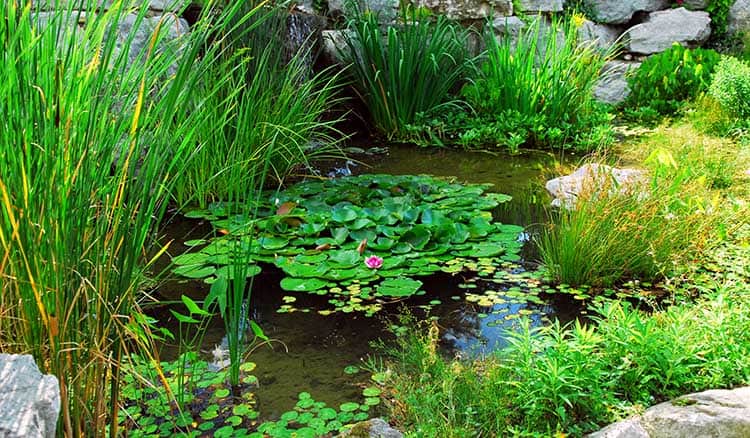
Plants play a big role in pond filtration. By adding plant life to your pond, you are carrying out a form of biomimicry. This means that your pond is functioning similar to the way a naturally occurring pond works. Plants make many contributions to a healthy pond environment.
- Purification – Plants remove toxins in the pond water.
- Nutrient Management – Plants absorb nutrients in your pond. If there are no plants to play this role, the nutrient levels will continue to grow contributing to multiple problems. Algae may feed on these nutrients eventually causing a bloom. If uneaten these nutrients will also contribute to a sludge build-up
- Wildlife support – Plants also provide food and coverage for any animals living in your pond such as fish and frogs.
Without plants, it is more likely that you will have a build-up of sludge in your pond. When designing your pond, don’t forget to include plenty of plants. Carefully select plant species that survive both in water and in your region.
Pond Maintenance
The last factor in creating a pond in your yard is maintenance. Regular maintenance is needed for any part of your landscape to operate at its best. This is especially true for ponds. Don’t add a pond to your yard if you aren’t willing to do the following.
- Clean your pond
- Manage plants in and around your pond
- Employ seasonal maintenance
Regular Cleaning
By now, you know that it is in your best interest to prevent a build-up of sludge in your pond. This requires regular cleaning.
As mentioned, you can use a net to minimize the amount of debris that enters your pond, or you can use a vacuum to remove whatever has already settled.
Manage Plants in and Around Your Pond
The more deciduous trees and shrubs near your pond, the more leaves will fall in. Consider pruning the plants that surround your pond so that they are less likely to drop their leaves in the water
In addition, you will want to care for your aquatic plants as well. If you don’t, they may die and add to the build-up of organic material at the bottom of the pond.
Employ Seasonal Maintenance
The seasons in which you need to pay the closest attention to your pond are winter and summer. The extreme temperatures that accompany these seasons can be detrimental to your pond.
In winter, prevent your pond from freezing over. If your pond is covered with ice, the oxygen won’t be able to enter the water. This prevents good aeration and may kill your fish.
To avoid this, you can use an environmentally-friendly deicer. You can also simply break up the ice as it forms.
In summer, evaporation may lower the level of your pond water. This also removes oxygen from the water which we know can lead to many problems.
Letting the water temperature rise too much can also affect the plants and animals living in your pond. When it is very hot jut spray some cold water into the pond to bring the temperature down.
Conclusion
A smelly pond is a major annoyance. What’s worse is that they are also hazardous to your health. If you have a pond in your yard, make sure you recognize the cause of your smell and deal with it accordingly.
Better yet, design, construct, and maintain your pond in a way that stops smells from showing up in the first place.

